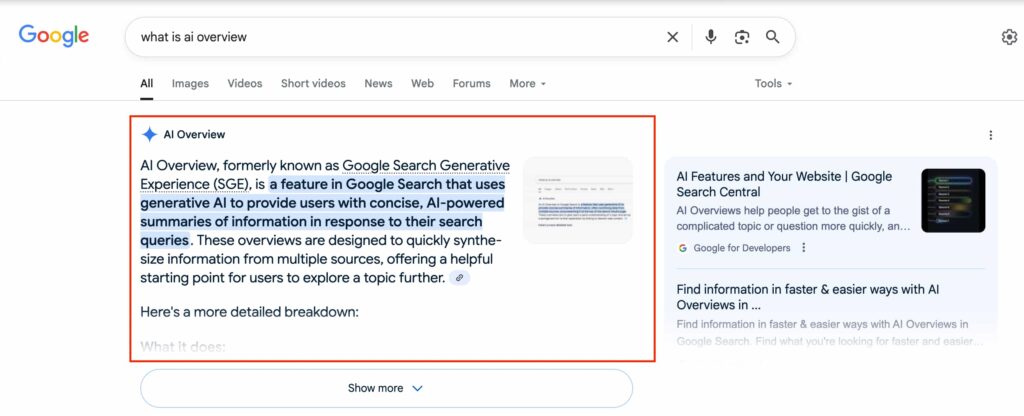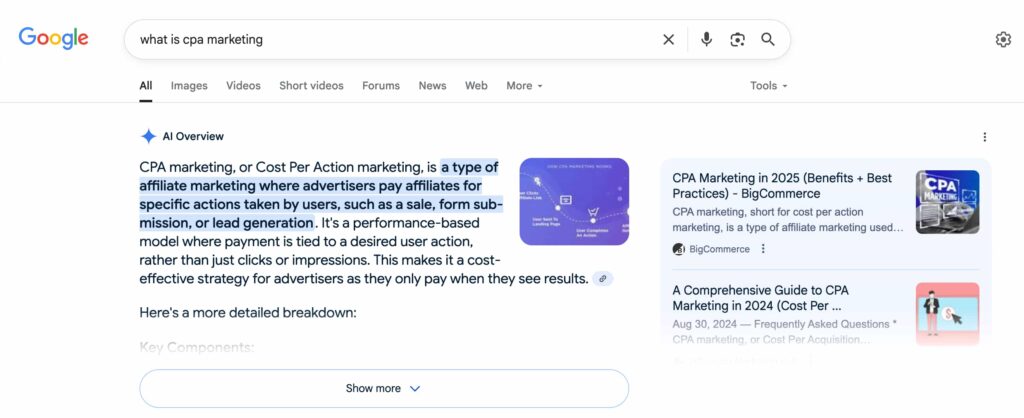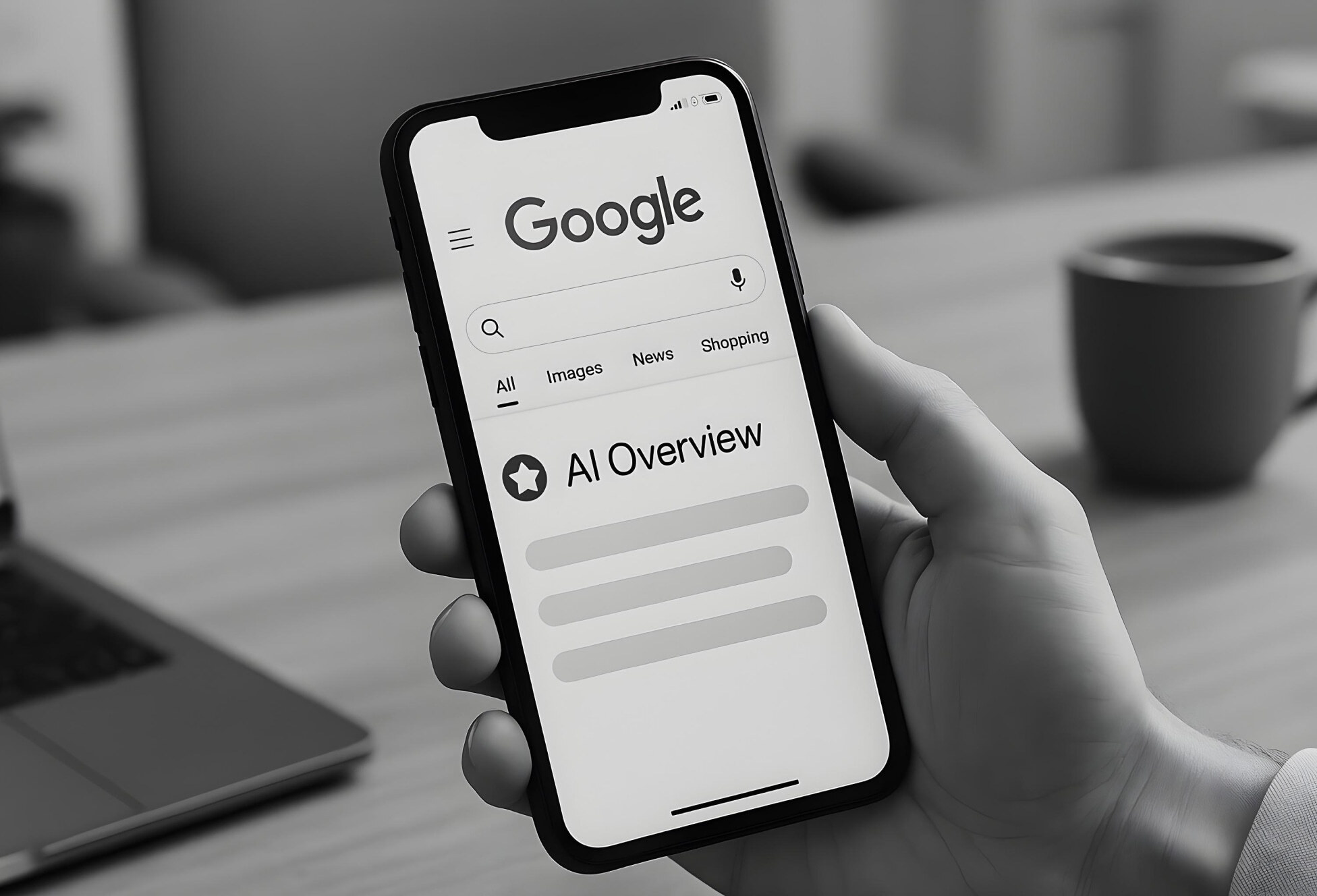In 2025, Google is a knowledge assistant that can understand your intent, pull from multiple sources and give you quick answers in seconds. The company has launched a Google AI Overview. It’s a new way of finding information in the search results page.
In this article, you can find an answer what is AI Overview, how it works and how to optimize content for search engine.
What is Google AI Overview?
AI Overview is a summary written by Google’s AI that answers your question instantly. It’s really useful feature. Instead of giving you a long list of blue links and making you click around to piece together information, the feature combines insights from multiple trusted sources into one simple AI-generated answer.
These overviews aren’t pulled from a single page. Behind the scenes, Google uses generative AI experiences in search that analyzes billions of indexed pages, detects the most important facts and weaves them into a short, easy to read summary. It also provides links, so you can dive deeper in the essence of the topic. It feels less like “search results” and more like a knowledgeable guide giving you a personalized briefing.
So, Google AI Overviews are part of a bigger shift from “find information” to “get answers”. Whether you’re asking about the best CPA networks, top GEOs for Gambling ads or what is pop traffic, the AI Overview gives you the key points in seconds, without losing the option to read the full article.

How Do Google AI Overviews Work in 2025?
Let’s take a look at how AI overviews in Google search works:
1. A User Asks a Question
You enter a question or make a request. Then, Google’s AI figures out what you really mean, looking at context, synonyms, and intent. If you search “Best GEOs for Nutra,” it knows you’re probably asking about affiliate marketing, Nutra vertical, offers, affiliate networks and programs, even if you didn’t spell that out. In 2025, Google can also process mixed inputs: text, voice, images, and even screenshots.
2. Google Searches for the Info
Once the intent is clear, Google’s system searches its index, which is now filled with vector embeddings – a way of storing information, so AI searches the content based on meaning, not just keywords. It pulls from the web, its own knowledge graph, and even live data feeds where relevant, like stock prices, weather, or sports scores.
3. AI Generates the Overview
Google synthesizes what it finds, cross-checks it against trusted sources, and writes an AI summary. Unlike traditional featured snippets that come from one site, AI powered search blend information from multiple sources to form a complete picture. The system also works to highlight citations, so you have a path to the original content.
Finally, the Google AI search results appear at the top of the screen, often with follow-up questions you can click for more info. It’s designed to be interactive, guiding you through a topic rather than leaving you to dig alone.
In general, AIO most often shows such info as:
- Information requests;
- Long queries;
- Queries with a large search volume.
Less frequently AI-powered search includes such quires as:
- Brands;
- Local requests;
- Short queries.

Why are Google AI-Powered Overviews Important?
According to the info, generative AI Overviews reached more than 1.5 billion monthly users in March, 2025. It’s 18.3% of the world’s population and 26.6% of Internet users. Also, AI Overviews cover 12.8% of Google’s total search volume. As far as you can understand, the feature shows great results in terms of search generative experience.
So, why it is crucial? Google AI Overviews are a fundamental change in how users find, consume and trust information online. Here are the main points why it is important:
1. Overviews Save Time
In a world where attention spans are short, and information overload is real, AI based search give you the answer in seconds. You don’t have to open 5 tabs, skip ads or dig past irrelevant sections.
2. They Change How We Browse
In traditional search approach, we follow several links and explore websites on our own. Google’s overviews change this pattern: a summary appears first, and links to sources become secondary. This means that we can generally click on fewer links, which is great for getting answers quickly, but it changes the direction of traffic to publishers and companies.
3. They Encourage Clarity and Authority
As AI Overviews are based on reliable, well-structured, and trustworthy content, websites with high expertise are more likely to be featured. This raises the bar for the quality of content on the internet by encouraging sources who can explain the topic clearly and accurately.
4. They Merge Multiple Perspectives
Unlike a single page snippet, AI Overviews can combine insights from multiple authoritative sources. That means answers are often more balanced, less biased and more comprehensive than something from one site alone.
In short, Google AI Overviews matter because they’re redefining what it means to “search”, from a link hunt to a conversation with a knowledge engine.
How to Optimize Your Content for AI Overviews in Search Results?
For users, Google AI search engine is really convenient as their search process becomes easier. But what about website owners and content creators? As far as you can understand, not all websites get in the overviews. The thing is that the content should be:
- Trustworthy;
- Clear and direct;
- Well-structured;
- Responding E-E-A-T;
- Optimized.
Let’s dive deeper in the essence.
1. Structure the Content for AI
Write clearly and to the point. Avoid long and vague statements. Instead, use clear subheadings (H1, H2, H3). They help the AI quickly understand the structure of the content.
Example structure:
- H1: Main topic;
- H2: Main sections;
- H3: Subtopics within sections.
2. Focus on Real Questions
Use the PAA (People ask too) or FAQ (Frequently Asked Questions) section to highlight some requests. Include conversational, sometimes even lengthy, questions in the list that may lead to new reviews.
Example: instead of the keyword “15-minute workout at home” use “What quick 15-minute workout can I do at home without equipment?”
3. Increase Readability
Add Brief Overviews or Key Takeaways at the beginning of the article. This helps AI and users to quickly understand the essence of the material.
4. Monitor the Brand’s Reputation in AI
Check regularly how your brand is described in ChatGPT, Gemini, and AI Overviews. If the data is incorrect, update all your profiles, “About Us” pages, Google Business and other important sources.
5. Strengthen Your Credibility
Get high-quality links from reputable websites.
Confirm your expertise:
- Publish research, case studies, and data;
- Specify the authors, their biographies, and achievements;
- Add certificates and awards to the website.
6. Work with Reliable Sources
Use links to reputable organizations and research in your articles. Avoid clickbait and misleading headlines.
7. Promote Social Signals and Feedback
Actively collect reviews on Google, Trustpilot, and Yelp. Get involved in user-generated content: comments, mentions, and discussions.
FAQ: How to Use Google AI Search
What are Google AI Overviews, and how do they work?
Google AI Overviews are short, AI-generated summaries that appear at the top of your search results. Instead of showing a single snippet from one page, Google’s AI scans multiple trusted sources, finds the most relevant points, and writes a simple, direct answer. You still get links to the original pages, but the overview is meant to give you the essence of the topic right away.
How do AI Overviews affect SEO and website rankings?
They don’t replace rankings, but they change how people interact with them. Since the summary comes first, some users may click fewer links. However, if your content is cited in an overview, it can lead to highly targeted traffic from people who are ready to dive deeper.
Can I optimize my content to appear in Google AI Overviews?
Yes. While there’s no magic formula, you can improve your chances by writing clear, well-structured content, using headings and bullet points, citing credible sources, and focusing on E-E-A-T principles (Experience, Expertise, Authoritativeness, Trustworthiness). The AI looks for content it can easily understand, verify, and trust.
What types of search queries trigger AI Overviews?
They tend to appear for complex or information-heavy queries like comparisons, “how-to” guides, research-based questions, or multi-part topics. You might also see them for trending subjects or common user problems. Short, brand-specific, or hyper-local searches are less likely to trigger them.
How accurate are Google’s AI-generated summaries?
They’re generally reliable, but not perfect. The AI pulls from reputable sources and tries to fact-check, but mistakes can happen, especially with fast-changing or niche topics.
How do AI Overviews differ from traditional search results?
Traditional results give you a list of pages to choose from. AI Overviews give you a ready-made answer first, then offer links if you want more depth.
Can users opt out of AI Overviews?
You can’t turn them off completely in the main search interface, but you can bypass them by switching to the “Web” filter in Google Search, which shows only traditional results. Most people still see the overviews by default.
Which industries benefit most from AI Overviews?
Industries with evergreen, fact-based and high-trust content tend to benefit most: healthcare, finance, education, technology, and travel. If your industry involves guides, comparisons, or research you have a better chance of being featured.
Conclusion
Google generative AI search is crucial search feature. It saves time, surfaces authority, clarifies complexity as well as changes how users browse and interact with online content.
For website owners and content creators, this isn’t something to sit back and watch. It’s a call to action. The sites that will thrive in the AI Overview era will be the ones that focus on trust, structure, expertise, and value for the reader.















